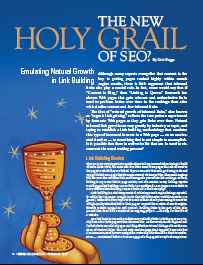The New Holy Grail of SEO?

 |
Emulating Natural Growth in Link Building - by Chris Boggs Although many experts evangelize that content is the key to getting pages ranked highly within search engine results, there is little argument that inbound links also play a crucial role. In fact, some would say that if "Content is King," then "Linking is Queen." Research has shown Web pages that gain relevant and authoritative links tend to perform better over time in the rankings than sites with similar content and few inbound links. |
The idea of "natural growth of inbound links," also known as "organic link gaining," reflects the true pattern experienced by fortunate Web pages as they gain links over time. Natural inbound link growth can vary greatly by industry or topic, and trying to establish a link building methodology that emulates this type of increased interest in a Web page - on an accelerated timeline - is something that is not simple to accomplish. Is it possible that there is a silver bullet that can be used to circumvent the usual waiting process?
Link Building Basics
There are two very important considerations to keep in mind when trying to build effective links. First, the most effective links come from pages that are relevant to the pages to which they are linked. If you own a site that sells gardening tools and you get links from a page that discusses current Tibetan politics, the search engines will discover the worthless link and downgrade your site in the rankings. Second, linking is a process that is page-centric, not site-centric. Many linking experts would argue that building 10,000 links to a combined 1,000 pages on a website is more effective than building 100,000 links all to the home page.
Link building is a vital component of achieving search engine listings, especially within the top pages. Google, in its detailed Webmaster Guidelines states, "In general, Webmasters can improve the rank of their sites by increasing the number of high-quality sites that link to their pages." Beyond the creation of search engine friendly website navigation and content, building links is the part of the SEO process that should be considered an ongoing project - literally, for the life of a website.
One last basic to remember is that many valuable links to Web pages are actually from other Web pages within the same site. As discussed, search engines look for links between related pages. Building effective internal linkage allows the creation of "instant links" that not only contain important targeted keywords but also increase ease of human navigation. Naturally, this should be done in moderation - 100 internal links to the same page of a 50-page site may look suspicious.
What is Natural Link Growth for your Industry or Topic?
If you are presenting a topic about "Newton's Laws," it may take months or years to build links as people discover the article from other research and end up linking to it - unless of course you have somehow properly refuted one of the Laws or added some groundbreaking new research.
In sharp contrast, when Hurricane Katrina struck the American south in August of 2005, there were very few if any websites or content about the topic. A search in Google for "Hurricane Katrina" (with quotes) in November of 2006 yielded an astounding 3.3 million results. When websites began presenting content related to Katrina, aid organizations, blogs, news outlets and many other Web pages began linking to those pages. This is an example of a situation where natural link growth actually occurred in the span of days and weeks, as opposed to the months that it would normally take.
Watching a page gain links naturally can be similar to watching grass grow, unless you try to spur things along by embarking on a link building campaign. It takes a special breed to have the patience needed to build links in a seemingly natural pattern while at the same time ensuring they will help drive traffic and rankings. The key is conducting research on the competition's links.
One could theorize that if the top sites for an industry have been around an average of three years, and they have an average of between 10,000-15,000 inbound links to the entire sites, it is fair to estimate that the natural growth rate for links in that industry is between 3,000-5,000 links per year. Theoretically, the longer a site or group of sites is in existence, the more accurate the estimated normal growth will be.
However, the main problem with this theory is that it is very difficult to identify which links are really making the difference for those sites. Some links may be completely useless, and it is possible the site may have been able to rank just as high thanks to its content as well as only a portion of the total links. One way to check is to look for the site that sticks out like a sore thumb - with considerably less inbound links than the others. Chances are this site has some very important links coming from what are known as "authority sites." Or, they can even be listed highly because they link out to many important related sites, classifying them as a "hub.
Hubs, Authorities and Possible Link Penalties
There are some excellent research papers on the subjects of hubs and authorities when related to Web linking patterns. The most often cited is by John Kleinberg. Essentially, the Internet is one large network comprised of many pages that link to and from each other - hence the term "the Web." The pages with many links from a variety of trusted pages can achieve the status of being an authority. Thus, as you search at Google, for example, Kleinberg's paper should come close to the top, since so many people have linked to it. A "hub," on the other hand, has many outbound links to trusted sites. In some cases, hubs can actually be comprised of entire websites instead of just pages.
Conversely, search engines are also known to devalue certain links to Web pages. For instance, a "site wide" or "run of site" link to a Web page that appears on every page of another site may be only counted as one link. So, getting 1,000 links from a 1,000 page website may not be the best way to try to jump the line when trying to speed up the natural process. Other methods of rapidly gaining links are sometimes easy for search engines to discern as well, especially if the links are in a known network of sites that exchange links. It is especially easy for search engines to identify these links when a link for a mortgage loan appears on a website that promotes cosmetic surgery.
Going for the Buzz
Site content can be leveraged as part of link building to create buzz, effectively increasing the viral marketing chances as well as driving unsolicited links to the site. Internet publishers such as bloggers, news writers and forum participants frequently link to desirable content. The term "link baiting" refers to the practice of building content within a website that will attract the links. Although some experts dislike the term, they agree that the ideology is sound. However, "build it and they will come" only works after a few people have seen the content and start virally promoting it through emails or links. The idea and possible benefits of leveraging Web 2.0 and social media websites would take another entire article to explain but can be very beneficial if done correctly.
What Others Say
In a recent interview, Debra Mastaler of AllianceLink.com was very brief stating, "Webmasters understand links carry value, they just fail to realize that ultimately links support content rather than define it." Her wisdom is evident as usual - you have to put the horse before the cart. Link building is like any other marketing channel. As Patrick Moorhead of Avenue A | Razorfish explains, "Channels should not drive decisions and execution. Rather, insights into products and consumers will lead to unique messaging, which will naturally indicate the correct channels to effectively deliver that messaging." This defines how link building should support content, not the other way around.
Mike Grehan, author of Search Engine Marketing (search-enginebook.co.uk), provided his usual matter-of-fact opinion: "Emulating natural growth in link building is being led by the nose, as far as I'm concerned. When I worked with a friend who opened a restaurant in London, we could have spent months trying to emulate ‘quality' linkage data using technology. But my mission was to get the three most important online food critics in London to visit the restaurant. Whether they reported online that the restaurant was good or bad - I knew we'd still get the links! And we did, so it worked. Emulate or create? I'd rather lead than follow.
Finally, the opinion which most mirrors my own on the subject, from linking guru Eric Ward (Ericward.com) says that "If we are going to be truly candid about natural link building then, frankly, natural linking can't be emulated. Emulated natural link building is an oxymoron. The moment you attempt to pursue a link is the moment it's no longer 100 percent natural. That said, your approach to link building can be 100 percent natural in terms of target site identification, and the resulting links obtained will, by extension, be counted as natural links by the search engines. When I'm link building, I seek out links only from sites that, content-wise, offer a logical, natural reason to link to my clients content in the first place, engines or not. This approach worked for me in 1994, and it works for me today. Give yourself the ‘Linking Acid Test.' If you knew Google did not give you any credit for it, would you still want the link? If you answer yes, you are on the right track. If you answer no, then watch your step.
Chris Boggs is a Search Strategist with Avenue A | Razorfish, creating and managing search engine optimization and paid search advertising campaigns.










